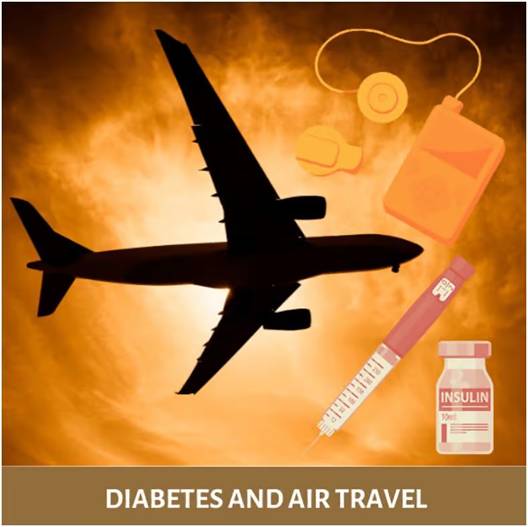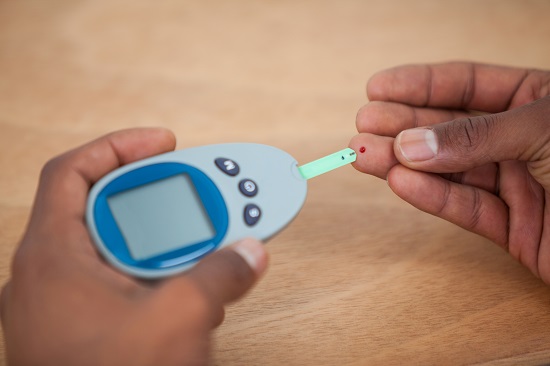An Air Travel Guide for Africans With Diabetes
By Chinonso Cynthia Ukah, BNSc, RN, RM, RPHN. Freelance Health Writer. Medically reviewed by: K. Craig, MBBS, MPH.

A black silhouetted airplane in a golden orange coloured background with an insulin vial, a syringe and continuous glucose monitoring device shown.
Travelling with diabetes doesn’t have to be stressful if you know what to expect. This travel guide will walk you through everything you need to travel by air while managing your blood sugar levels as an African.
Diabetes mellitus (Type 1 & Type 2) is a metabolic condition that affects blood sugar regulation. If you have Type 1 diabetes, insulin is a necessity and this makes proper travel planning essential. Type 2 diabetes may not always require insulin, but air travel still comes with precautions you shouldn't ignore.
If you're a diabetic traveller, caregiver, or healthcare professional in Africa, this guide will equip you with accurate information to help manage blood sugar whenever you or your client travels.
Let’s dive in.
Because diabetes doesn’t take a break, travelling by air with diabetes is not just about booking tickets and packing your luggage the way airport security and your airline want.
Your blood sugar levels can fluctuate due to time zone changes, travel stress, high-altitude effects, and limited food options. Checking in with security may require extra steps when carrying insulin, syringes, or a glucose monitor. Unexpected delays may force you to adjust your medication schedule, and these delays are almost guaranteed when you're travelling by air in most African countries.
These factors can turn a simple journey into a health risk if you don’t plan properly. That’s why you need this guide to stay informed, stay safe, and travel without complications.
Travelling by air puts the human body through a series of changes that can cause irregularities to your blood sugar.
Flying changes the normal functioning of the body, and the effects can be serious if you have diabetes. But once you know what to expect, you can plan ahead and maintain a healthy blood sugar level throughout the flight. Let’s get into how to do that.
To avoid last-minute stress or unexpected complications during your journey, here’s a list of essentials you should always have with you before boarding a plane.
Travel checklist for people with diabetes. Click on image to enlarge.
Get your copy of the diabetes travel checklist here.
More on the Air Travel Checklist for People with Diabetes
.jpg)
Insulin bottle, syringe, glucose test meter nd test strip with other diabetes suplies on blue background. Image credit: Freepik
There may be delays and you can lose your luggage at the airport or bus station. Also, running out of insulin in the middle of your trip is not an option. Pack more insulin than you think you’ll need. The Center for Disease Control recommends carrying at least double your usual amount.

Hands holding a glucose meter and test strip.
You’ll need to check your blood sugar more often while on the plane and in the bus, so make sure your glucose meter, test strips, and a lancing device (lancets or pens) are working and at your reach. Remember to add extra batteries, power bank or your charging cable if your device needs one.
.jpg)
Doctor’s diabetes medication prescription
Airport security can embarrass or frustrate you, especially when you're travelling with medical supplies and no proof of your condition. A doctor’s note helps prevent this by explaining your condition, and a prescription ensures you can get a refill if your medication is lost or runs out. If you don’t have one, ask your doctor before you travel.
A sample of diabetes travel letter. Source Click on the image to enlarge.
This is an official letter that explains your diabetes, the medication and equipment you’re carrying, and why you need them. Some airlines or security officers might ask for it, especially if you’re carrying syringes, insulin pumps, or CGMs (continuous glucose monitors).
.jpg)
An insulin passport on a carry-on: Freepik
Not all countries use the same insulin brands. An insulin passport helps pharmacists abroad identify the type of insulin you use and find a close alternative if you need a replacement. It’s a small but important document that can save you a lot of stress with getting your insulin replaced.
.jpg)
A diabetes calculator: Source
Because of the difference in time zones, you may need a diabetes travel calculator. If you're travelling from Ghana to the U.S., for instance, you’re moving across multiple time zones and essentially lagging in time. A diabetes travel calculator calculates when to take your medication as your body adjusts to the new schedule, keeping your blood sugar stable throughout your journey.
.jpg)
A sampling of diabetes friendly healthy snacks for diabetes.
You may not find the normal foods you eat when you arrive at your new destination and food served on the plane is unpredictable. Pack roasted plantain chips, roasted nuts, sugar free crackers or whatever works best for you to maintain your blood sugar level. Keep them in your carry-on (hand luggage) where you can assess them easily.
.jpg)
A diabetic medical alert ID: Source
A diabetic medical alert bracelet or necklace is an identity worn on the hand or neck to help you in cases of emergency. If something happens on the way or in a foreign country where you don’t speak their language, this small piece will let people know you have diabetes and need immediate help.
9. Emergency contact card
Sample emergency contact card. Click on image to enlarge.
This list should contain the names and phone numbers of people to call if you are in a place where people don't know you. You can add your doctor, spouse, family, or local emergency services to the list. If something goes wrong like if your blood sugar crashes, these should be your go-to contacts. Save it on your phone and also keep a written copy in case your battery runs low.
.jpg)
A sample carry-on luggage for important diabetes supplies and medications
Never put your medications in a checked luggage. You don’t want to be stranded without your insulin or other medications if your bag gets lost. Always keep them in your carry-on or hand-luggage, and bring more than you think you’ll need.
.jpg)
Insulin cooler case
Insulin must be stored at temperatures between 2–8°C to stay effective, 2-30°C if you use a pen or vial. Anything outside this range can damage it, and airplane conditions don’t guarantee safe storage. Carry your insulin in a temperature-controlled case in your hand luggage to keep it safe throughout your trip.
.jpg)
A travel insurance policy is a necessity for air travels by diabetics.
Medical emergencies are expensive, and diabetes-related issues aren’t always covered by standard policies. Look for travel insurance that covers pre-existing conditions like diabetes. Some plans can reimburse you if a diabetes-related emergency forces you to cancel or cut your trip short. Make sure to get coverage before you travel because waiting too long might leave you without protection when you need it most.
13. Pre-request diabetes-friendly in-flight meals
.jpg)
A sample pre-ordered diabetes-friendly meal served on an airplane. Freepik
Airplane food doesn’t always cater to diabetics. If you’re on a long-haul flight, pre-request a meal that suits your dietary needs. But even then, don’t rely on the airline. Bring your own backup snacks just in case.
.jpg)
A refillable water bottle.
Airplane cabins, the pressurized sections where passengers sit are very dry. This dry air can dehydrate you, causing your blood sugar to rise. Also, some parts of Africa are also very hot and you can lose fluids faster in these regions. To stay hydrated, bring a refillable water bottle and fill it up for use while travelling.
.jpg)
Extra batteries and charger
Your glucose meter, insulin pump, or CGM is useless if it goes off in the middle of your trip. Always pack extra batteries and a portable charger. You don’t want to be stranded at 30,000 feet with a dead device and no way to check your sugar.
16. Comfortable shoes
.jpg)
A sample of comfortable shoes for air travel
Swollen feet are common on long journeys, especially in airplane economy class. If you have diabetes and are travelling for a long period, you need to pay extra attention to your feet. Tight shoes, prolonged sitting, and lack of movement can lead to blisters and subsequent foot ulcers. Wear comfortable, breathable shoes, stretch your legs often, and walk around at intervals during the flight to keep blood flowing to your feet.
Getting through airport security with your diabetic medical supplies can be tough if you don't plan well. But knowing what to expect and following through with it can make things a lot easier.
If you’re travelling with insulin, don’t put it in your checked luggage, it’ll end up in the cargo hold, and that’s a fast way to ruin it before you even land. Keep your insulin in your hand luggage. Ideally, store it in an insulated bag with a cooling pack to keep it at 2–8°C, like it should be.
.jpg)
Tubular Insulin and syringes cooler travel case
Some security personnel at African airports may express concerns about you travelling with needles and syringes in your carry-on luggage. To avoid unnecessary drama, carry a doctor’s note or prescription that clearly states you need them for medical reasons. Keeping your insulin in its original packaging with a prescription label can also save you time at security.
Security rules vary, and African airports may not always follow international standards to the letter. Here are some key things to keep in mind:
If the security officers at the airport question your medical supplies, stay calm and politely explain why you have them with you. If you run into trouble, ask to speak to a supervisor or a medical officer at the airport.
Also, some airlines allow pre-boarding for passengers with medical conditions. If you need extra time to settle in, let the airline staff know before boarding and also, be prepared for the unexpected.
Now, let’s talk about managing blood sugar while travelling by air.
1. Ugurlu M. Flight and diabetes. Anatol J Cardiol. 2021;25(Suppl 1):20-23. doi:10.5152/AnatolJCardiol.2021.S108. Available from here
2. Centers for Disease Control and Prevention. Tips for travelling with diabetes. [Internet]. 2024 May 15. CDC Atlanta, [Cited 2025 Mar 30]. Available from here
3. Cambridge University Hospitals NHS Foundation Trust. Travelling with diabetes and insulin injections [Internet]. 2024 April 4. [Cited 2025 Mar 30]. Available from here
4. HealthXchange, Singapore. Travelling with diabetes: What to pack and how to store insulin. [Internet, n.d.]. [Cited 2025 Mar 30]. Available from here.
5. Diabetes UK. Travel and diabetes. [Internet, n.d.]. London [Cited 2025 Mar 30]. Available from here
Related:
Published: April 20, 2025
© 2025. Datelinehealth Africa Inc. All rights reserved.
Permission is given to copy, use and share content for non-commercial purposes without alteration or modification and subject to source attribution.
DATELINEHEALTH AFRICA INC., is a digital publisher for informational and educational purposes and does not offer personal medical care and advice. If you have a medical problem needing routine or emergency attention, call your doctor or local emergency services immediately, or visit the nearest emergency room or the nearest hospital. You should consult your professional healthcare provider before starting any nutrition, diet, exercise, fitness, medical or wellness program mentioned or referenced in the DatelinehealthAfrica website. Click here for more disclaimer notice.